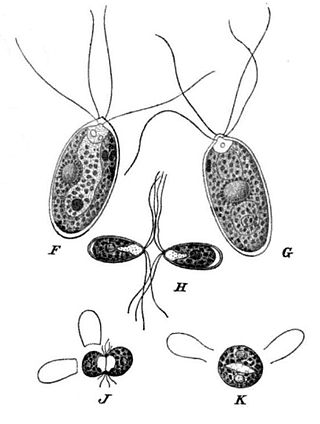
Chlorococcaceae is a family of green algae, in the order Chlamydomonadales. They are mostly soil-dwelling algae. Many members of this group produce lipids and secondary carotenoids.

Asterococcus is a genus of green algae in the order Chlamydomonadales. It is planktonic in freshwater ponds and lakes, or benthic within mires and swamps. It is a common and widespread genus, but is rarely abundant.

Bracteacoccus is a genus of green algae, the sole genus of the family Bracteacoccaceae. It is a terrestrial alga commonly found in soils, from the tropics to the poles.

Carteria is a genus of green algae in the family Chlamydomonadaceae. Carteria are similar in morphology to the common genus Chlamydomonas and differ by having four, rather than two, flagella at the vegetative stage.
Characiochloris is a genus of green algae in the family Characiochloridaceae. Characiochloris is epiphytic on freshwater algae, or found in soil.
Characiosiphon is a genus of green algae in the family Characiosiphonaceae. It contains a single species, Characiosiphon rivularis.
Dictyochloris is a genus of green algae in the class Chlorophyceae. It is the sole genus of the family Dictyochloridaceae. It is commonly found in terrestrial and subaerial habitats.

Lagerheimia is a genus of green algae in the family Oocystaceae. It is commonly found in freshwater habitats all over the world, although some species are rare and have only been recorded from Europe or the United States.
Lobocharacium is a genus of green algae in the family Characiosiphonaceae. It contains the single species Lobocharacium coloradoense. It has been isolated from a pond in Colorado, United States.

Neochloris is a genus of green algae in the family Neochloridaceae. It is found in freshwater aquatic and terrestrial soil habitats.

Planktosphaeria is a genus of Chlorophyceae of the green algae. It was first described by the phycologist Gilbert Morgan Smith in 1918, with Planktosphaeria gelatinosa as its type species. Species of Planktosphaeria are commonly found in freshwater plankton around the world.

Treubaria is a genus of microscopic green algae, the sole genus in the family Treubariaceae. Treubaria is found in freshwater habitats and has a cosmopolitan distribution.
Vitreochlamys is a genus of green algae in the family Chlamydomonadaceae. It is sometimes known by the name Sphaerellopsis, published by Aleksandr Arkadievich Korshikov. However, that name is an illegitimate later homonym, preceded by SphaerellopsisM.C.Cooke. It is commonly found in freshwater habitats.
Characiellopsis is a genus of green algae in the family Characiaceae. Two species are known: Characiellopsis anophelesii and Characiellopsis skujae.
Deuterocharacium is a genus of green algae in the family Characiaceae. It is found in freshwater habitats, attached to algae or detritus. It is rare and has only been recorded from Europe.

Chlorotetraedron is a genus of green algae, in the family Neochloridaceae. The name may also be written as Chlorotetraëdon. It is found as freshwater plankton or in soil.

Chlorokybus is a multicellular (sarcinoid) genus of basal green algae or charophyte. It has been classified as the sole member of the family Chlorokybaceae, which is the sole member of the order Chlorokybales, in turn the sole member of the class Chlorokybophyceae. It grows on soil and rock surfaces, and is rare.

Klebsormidium is a genus of filamentous charophyte green algae comprising 20 species. The name was proposed in 1972 to resolve confusion in application and status of Hormidium and was given for the German botanist Georg Albrecht Klebs.
Cecidochloris is a green algae genus in the family Chlorangiellaceae. It occurs in freshwater. However, it has only been reported so far from Europe, with an additional species from India that is incompletely described.
Bracteamorpha is a genus of green algae in the order Sphaeropleales, and is the only genus in the family Bracteamorphaceae. It contains a single species, Bracteamorpha trainorii.










